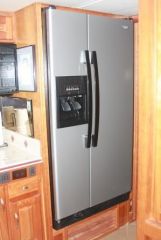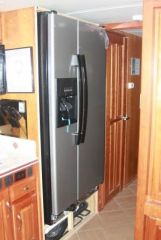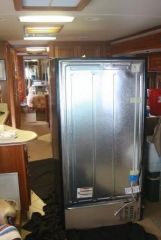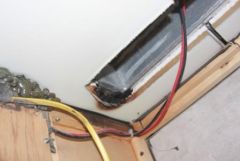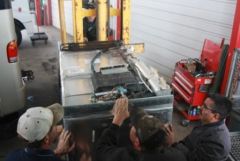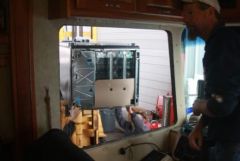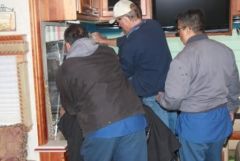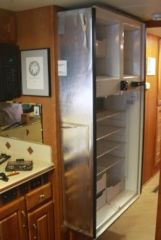-
Content Count
2713 -
Joined
-
Last visited
-
Days Won
44
Content Type
Profiles
Forums
Blogs
Gallery
Everything posted by tbutler
-
There is no way that any other route will be close to as scenic so don't pass up the trip along Going to the Sun Road. Just leave the rig parked and enjoy the view on one of the tour buses or cars. For a route around, any other road will give you great scenery, you are going through the Rocky Mountains, but it won't equal the amazing views of glaciers (small in those hanging valleys) and the waterfalls from the hanging valleys to the main valley floor. Pick a day when the weather is clear, the high portion of the road is sometimes clouded (fogged) in and you'll miss some of the spectacular views on cloudy or foggy days. If you have children with you they will want to stop and play on some of the snow fields along the road or at the visitors center on the continental divide. Check to see if your tour makes stops along the way. Because you will be seeing some of the best examples of glacial erosion on Going to the Sun Road, I would recommend that you do a little reading on valley glaciers and the erosional features they leave behind when they melt. The main valley is a classic glacial valley (very straight, only a slight bend) with hanging valleys, waterfalls and cirques all visible from the road. To really appreciate the features it helps to understand how they were formed. When you do that, you can visualize the system of glaciers that filled and formed the valley you are viewing.
-
An outlet for air hose connection might not be as valuable as you think. While I did find it handier to use than going to a station for air, I have abandoned the use of mine. I inflate the front tires to 110 pounds. The air pressure system on our coach cycles between 130 pounds at cut-out, quickly down to 110 psi, the operating pressure. At 110 pounds, you can't get the last 3 or 4 pounds in the front tires and the pressure in the system doesn't drop enough to cycle so I have to manually drop the pressure by pumping the brakes or opening a valve. Then if I can catch the pressure between 110 and 130 before the air compressor cycles off again, I can get the last few pounds in to get one tire to pressure. Then on to the next tire! The rear tires are a little easier but at 100 psi they still take a while to get the last few pounds. When we parked for the winter, I always tried to inflate tires to their maximum, 120 psi, but could never get that done for all six tires. It is almost impossible to get one tire to that pressure with the system described above. I looked at many inexpensive air compressors and finally purchased an air compressor at Lowe's for a little over $100 on sale. It is larger than I would have preferred but it turns out to be just what I was looking for as far as function. It operates between 130 and 150 pounds which gives me enough pressure to quickly inflate all my tires. It saves me idling my engine for 20 minutes or more to make minor adjustments in tire pressures. Now when I park the motor home for the winter, all the tires are inflated to 120 pounds and I can adjust as necessary quickly and easily during the winter. It has also been handy for operating air tools at home. I hardly use my built-in air hose connection any more.
-

Motorhome With Rear Axle vs Rear Axle With Tag Axle?
tbutler replied to Fliphoppers's topic in Type A motorhomes
I won't say anything negative about a tag-axle coach since I have never had one. What kind of fuel mileage do you get with a larger engine and higher gross weight (the tag adds 5000 pounds by itself)? How much does the tag axle and larger diesel engine add to the purchase price? How many axles do you pay for when you go through the toll booth? Will any of these cost factors affect how much you spend on traveling and enjoying your travels to the fullest? -
Get a good bicycle rack for a 2" receiver. When you decide to tow a car, you can move the bicycle rack to the 2" receiver on your car. If you don't think the car will have a 2" receiver, go for a 1" receiver and use an adapter for the motor home. If your car doesn't have a receiver, you can always add one that will handle a bicycle rack. I wouldn't trust any bicycle rack as an in-between for the motor home and toad. There is an internet company, etrailer.com that has a very extensive product line of bicycle racks. You might find something that will work for you or at least some ideas of what to look for.
-
You can look up information and reviews on campgrounds on RV Park Reviews. I checked and KOC in Norman, AR has one review from this year. Marilyn's RV Park is listed under Mt. Ida and has three reviews but all are from 2006 and 2007. If you stay at either of these parks your reviews will be helpful to others.
-
If you have the time and resources, I'd make the trip through Canada since you haven't been in this area before. You haven't indicated any particular interest so here are a few possibilities. By the way, we've traveled there but don't live there so we'll hope some natives will add their thoughts! The scenery going north from the Vancouver area on Canada Hwy. 1 along the Fraser River is spectacular. Lake Louise is well worth some time to explore if you like to hike. We visited the Fairmont Chateau on Lake Louise and caught a performance of a Swiss Alpine Horn by a retired Canadian military veteran. It was a truly spectacular setting and the performance was quite moving. We visited with the man for quite a while after the performance. We also enjoyed the shops in Lake Louise including an art shop there that had a wonderful sculpture by an Inuit native, from Baker Lake, Barnabas. Louise decided we had to take it home! East of Calgary are a number of dinosaur sites including Drumheller which has a number of popular dinosaur attractions including the world's largest dinosaur. The Royal Tyrrell Museum is well worth the visit. They have extensive dinosaur fossils and great geologic information. We pursued many of the hoodoo formations around the area but they aren't as dramatic as others we have seen. South of Calgary is the Head-Smashed-In Buffalo Jump, a location where peoples of the first nations drove herds of buffalo over a cliff. This is evidenced by the discovery of a huge pile of buffalo skulls at the base of a cliff. The museum there details the discovery and the history of the buffalo drives and the people who conducted them. The best of the hoodoo sites is just east of there at Writing on Stone Provincial Park. In Regina the Royal Canadian Mounted Police Heritage Center (Academy and Museum) is a very interesting stop. We also enjoyed the Royal Saskatchewan Museum. We had friends to show us around the Winnipeg area and enjoyed several sites there. We toured the Royal Canadian Mint and spent a day at the Lower Fort Garry National Historic Site. We also were lucky enough to visit Gimli, north of Winnipeg, during their Viking Festival. We just missed the 25th year reunion of the crew of the Gimli Glider by a week but did go see the airstrip where this 767-200 which had run out of fuel landed with no loss of life! We also missed the performance of the RCMP Musical Ride in Winnipeg by a week but were able to see it on a visit to Ashern, a small town north of Winnipeg. Seeing the Musical Ride in a small town location like this was probably the best possible way to enjoy it. They are in Saskatchewan now and will be until June 8 so perhaps you could see them in a small town there. If you go through Duluth from there on the way to the UP of Michigan, we recommend the Lakehead Boat Basin Campground which is on the parking lot of the Duluth Marina. You can watch the boats come and go including the Great Lakes freighters. There is a vertical lift bridge which admits the freighters to the harbor and you can see it from your motor home. The campground is within easy walking distance of a variety of downtown restaurants and the Great Lakes Aquarium. We found the drive across this entire route to be very interesting. It is a good look a the northern Great Plains with its massive production of grain crops. There are many "old style" grain elevators. If you like to photograph old barns, farm equipment, etc. you'll have to stop to get pictures of some of the elevators. Also of interest, watch for signs for local attractions. We found an amusing abundance of the "world's largest" items as tourist attractions in the prairie towns. Enjoy your trip.
-
Thanks Gary, I hadn't read the whole thread and missed this. I must say that this seriously complicates the whole program. I passed up the Flying J in Warrenton, MO today and fueled at Mr. Fuel in Foristell, MO at $3.799, no cash/credit price, just $3.799 for everyone. Best deal around!
-
Yesterday I stopped at Bosselman's Pilot, Exit 54 on I-70 in Kansas. Despite the bright red canopies over the pumps with Pilot clearly printed on them in large letters, they do not honor the discount because as the clerk stated they are Bosselman's, not Pilot. They are listed on the Pilot web site and their cash fuel price was the best I could find on our route of travel so stopped there but didn't get the cash price or any discount at all from the credit price. And yes, I followed the procedure as outlined above and on the Pilot web site. The card reader on pump 22 was posted as inoperable so I went inside and presented R.V. Real Value card and my credit card. If the clerk was correct and they don't honor the Pilot programs then they should be removed from the web site or there should be some disclaimer (an asterisk or footnote) indicating that they are some kind of affiliate that is not really a Pilot Center. I don't know what the clerk was thinking when I presented my R.V. Real Value card with my credit card before the purchase. I would guess she thought it was for entertainment. Nothing was mentioned about the card not being accepted at their location until I had finished pumping fuel and was presented with the bill. I've contacted Pilot via e-mail regarding this incident, awaiting reply. When I get some kind of response from Pilot, I'll post it here.
-
We use a heated mattress pad as a way to warm the bed before crawling in at night. Sometimes DW likes to keep it running all night long. These are Sunbeam (Mfg. in China) and we're on our third or fourth because we forget to unplug before going on the inverter. It isn't the heating element but the electronic controls that won't deal with a modified wave inverter. They even go out if we haven't turned on the heat, if they were plugged in when the inverter was on they were fried. We haven't risked using it on the sine wave inverter we installed two years ago. We've become very careful not to leave it plugged in when we aren't plugged in to shore power. There are some electronics that won't tolerate the modified wave power.
-
Our winter this year was spent in our new mobile home in Sandpipers Resort in Edinburg, Texas. The motor home has been seriously neglected during this winter. We don't have to winterize in the normal sense. Tanks are drained and the refrigerator emptied and unplugged. We left the heat on and air conditioning when needed. Tires were inflated to maximum inflation pressure and we were parked on wooden blocks. I did wash the motor home several times through the winter and we were in and out moving items to and from the motor home. Still, we were occupied with the new house more than the motor home this winter. This is quite a change after almost ten years living full time in the motor home. Our goal was to leave south Texas on Sunday, May 1. Everything was going according to schedule until Louise came down with a serious cold just days before we were to leave. Fortunately, she had a good head start getting things into the motor home before the cold hit her. The final day was mine with all the mechanical things to tend to, check fluids, fill fresh water tank, move the coach off the blocks and adjust tire pressures. I finished loading the last of my personal items and closed up the house about 5:00 p.m. - yes, 5:00 p.m. We had delays, the starting batteries now 7 1/2 years old decided today was the day to quit. I started the coach using the battery boost from the house batteries. Then the Trailblazer wouldn't shift into neutral for towing. It has a chronic loose connection that no GM dealer has been able to fix. After a number of tries we finally get a shift and we're on our way - out the gate at 6:30 p.m. Our first stop was just 200 miles down the road. We were scheduled for maintenance at Iron Horse RV in San Antonio. Top of the list was to replace the starting batteries. Then there was a drip from the hot water heater that turned out to be a loose connection. That took several tries and replacing a broken fitting to finally solve that problem. The water pump was failing so it was replaced. The big job was replacing the refrigerator. The Norcold 1200 had finally become unusable during our last trip of the fall so when we unplugged it for the winter I knew it was the last time it would run. Our food was packed in ice chests for this trip, it would be transferred to our new refrigerator once it was installed. We chose to have a residential refrigerator installed in place of the Norcold. Iron Horse identified a model which would come close to fitting the space occupied by the Norcold. It was about 4 inches taller and three inches deeper but was the same width. Removing the old and installing the new took about two days with some interruptions for our tech to do other jobs on our coach and occasional assists working with other coaches. We left Iron Horse RV about 2:30 p.m. on Wednesday with good batteries, a working water pump, no drip from the water heater and a cold refrigerator. We spent the night at Riverside RV Park in Waco and then drove to MCD Innovations in McKinney, Texas the next day. The first of our pleated shades had broken just before we parked in the fall and we were unable to get repair because the shade couldn't be disassembled. Knowing that all the rest of the shades are 7 1/2 years old, we decided to replace the whole lot. Being on a schedule we elected to have MCD Innovations measure the windows for us and then ship us the shades for self installation later. With the roll up day/night shades and all our other fix ups we'll have a much improved coach. They got us measured Thursday afternoon and we were ready for an early morning departure on Friday. Our next destination was Denver, Colorado for a family wedding. It is an easy two day drive of about 400 miles each day. We had never driven the route from McKinney to Amarillo before and I really enjoy seeing new country and a new road. From Amarillo to Denver is a route we've traveled many times. We stayed overnight at the Wal-Mart in Dumas, our first night boondocking with the new refrigerator and it did just fine running on the inverter for the night. We arrived at Golden Terraces RV Park about 3:00 in the afternoon on Saturday, right on our planned schedule. Now we have a week of preparation for the wedding. Family visits, planning, scheduling, and on Saturday our youngest niece will be married. For now, we're sitting out a fine spring rain in Denver. The temperature is a cool 43 degrees. Wednesday morning I brushed snow off the Trailblazer. It is good to be back on the road again.
-
- Travel
- Leaving Home
-
(and 5 more)
Tagged with:
-
I'm not familiar with the Onan Micro 4000 but our Onan 7500 has a series of error codes that display on the start button as flashing lights. The sequence of flashes indicates the code. We had ours act similarly, it turned out to be a faulty temperature sensor that was shutting the unit down, thinking it was overheating. We had the sensor replaced and it has worked fine ever since. Check your owners manual for the error code sequence or call Onan for instructions on how to get a code if yours does display one. So now I've read your sub-heading, and yes you do have error codes and you have read them! I'd guess a faulty sensor of some kind. You might call Onan, give them the code and get their ideas for solutions.
-
Romy1234, Your route south along the east coast of the US will take you right through all of early US history. There are many sites related to early settlements, the revolutionary war, the civil war and the US capital in Washington, DC as well. A good place to start would be The National Park Service. I chose just one state, Massachusetts and it lists 15 National Parks, 4161 National Register of Historic Places, 5 Natural Heritage Areas, and 185 National Historic Landmarks. You could browse through these and pick out a few things that look interesting. A must see for us was the Freedom Trail in Boston. A day of walking through Boston from one Colonial and Revolutionary War site to another. From old buildings and cemeteries (names from history books on the tombstones) to battlefields, this is a fascinating journey back in time. I would also recommend a stay in the Washington, DC area for several days. There is good subway service throughout the city so you can stay an hour away and park at the end of one of the subway routes and see the whole city without having to drive and park. There are more monuments than you can see in a week and the Smithsonian Museums would be another week! At least a day on the Capital Mall and another at one of the Smithsonian Museums would be recommended here if time is limited. If you are interested in scenic roads this site will guide you along some beautiful drives and to interesting places. I chose Virginia and it features five routes including the Blue Ridge Parkway (parts may not be suitable for your motor home), the 23 mile long Colonial Parkway, The George Washington Memorial Parkway, the 180 mile Journey through Hallowed Ground Byway through Maryland, Pennsylvania and Virginia and Skyline Drive in Shenandoah National Park. It also lists seven other routes in Virginia. Take your pick or see them all. For offbeat interesting things to see and do, I recommend Roadside America which is a site dedicated to the unusual and sometimes bizarre tourist stops. For campground information along the way, RV Park Reviews will help you find suitable places to stay. I can't make recommendations regarding campgrounds in Florida but we winter every year in south Texas. We've stayed in Corpus Christi on occasion and there are good campgrounds there, see RV Park Reviews for descriptions of the many in the area. If you are looking for activities, dances, performances, etc., you can't beat the campgrounds in the Rio Grande Valley (RGV). The RGV is about 135 miles south of Corpus Christi and the temperatures are much warmer. US Highway 77 South will take you to Harlingen where you intersect US Highway 83. Going east/south from there is Brownsville and South Padre Island which has Isla Blanca State Park with campsites a short walk from the beach. Going west takes you into the heart of "Winter Texan" country. There are lots of campgrounds, some small, some huge. Some have their own dance halls with dance lessons and regular dances, others are located right next to World Birding Centers where you can see exotic birds from Central America along with a host of migratory birds from North America. You can find any chain restaurant and many unique restaurants in the area. The natives are friendly which is a huge difference from what you find in Florida. There are theater and symphony performances, a minor league hockey team, basketball team and baseball team in the RGV. We stay in a park near Edinburg, Texas and our park has so many activities that no one can keep up with all of them. With a heated pool and hot tub, there are water volleyball games throughout the winter. We have an organized golf outing each Monday morning, a bicycle ride on Tuesday morning, a bowling league on Friday mornings and karaoke, dances, performances on weekends. There is a book club, a quilting group, a motorcycle group, ladies luncheon group and much more. You can find most any card game you are interested in and there are evening activities such as bingo, Mexican bingo, dominoes, poker, etc. We have tennis courts, shuffleboard courts, petanque courts and a new activities building is being constructed this summer. It will house the ping-pong, air hockey and other games as well as the card games mentioned above. We have happy hour at 4:00 and friends will get together for dinner any evening of the week. We have a part time restaurant in the park with occasional meals prepared by a chef. I wouldn't say our park is typical but it represents some of the things you will find in parks in the area. If you can't find these activities in Corpus Christi, you might move a little further south. Since you are near Montreal, I would mention that there are no shortage of Canadians in the RGV and many of them speak French. I suspect that most parks here have many French speaking residents through the winter. Your return north in the spring (don't leave too early!) could include some time in San Antonio where you could explore the River Walk and see the Alamo. Houston has the NASA Manned Spaceflight Center which you could see in either direction of travel. Stop in Amarillo for the Quarter Horse Hall of Fame and Museum or in Oklahoma City for the National Cowboy and Western Heritage Museum. On east on I-44 in Claremore, Oklahoma is the Will Rogers Memorial Museum which has a great deal of information about this cowboy philosopher. You'll leave with a smile on your face! Stop at the original Bass Pro Store in Springfield, Missouri if not to shop for outdoor gear, just to wander through the amazing displays. In St. Louis there is the Gateway Arch and Riverfront. Continue on north on I-55 to Springfield, Illinois and the land of Lincoln. There are a number of historic sites in Springfield related to Lincoln including the Lincoln Home, the Presidential Library and the Lincoln Tomb. Then, go on to Chicago with the Chicago Art Museum, The Museum of Science and Industry, the Shed Aquarium, the Field Museum of Natural History, The Navy Pier and a host of other attractions. On to Detroit and the Henry Ford Museum. Continue Over the Ambassador Bridge and you're back in Ontario! Enjoy
-
In 2004 we stayed in Custer Crazy Horse Campground and found it to be quite friendly. It doesn't look like it is getting very good reviews these days. You can check it and a number of other campgrounds around the town of Custer at RV Park Reviews. You can also investigate campgrounds all over the US on this site. If you are so inclined, you can contribute your own ratings and comments on campgrounds where you stay.
-
One of the considerations in changing tire size is to make sure that the new tire size will allow proper spacing between the dual tires. If the new tires are wider it will reduce the space between the dual tires. This spacing is critical for maintaining proper cooling of the tires. In a worst case scenario the tires would kiss when in contact with the road. This will result in tire failure in a short period of time.
-
Last fall when we parked our motor home next to our new mobile home at Sandpipers Resort in Edinburg, Texas, we had several repair items on our list. The top of the list was to replace the old Norcold 1200. Since there have been so many recalls we decided to convert to a household refrigerator. We had a history of working with Iron Horse RV in San Antonio and so we called them to ask if they had any experience doing such a conversion. As luck would have it, Daryl, owner of Iron Horse RV answered the phone. We had a short conversation in which I learned that yes they have done conversions. In fact, Daryl said he had converted his own motor home to a household model. I asked a few questions and said good bye. As soon as I hung up, questions came to mind so I called back. I got into an extended conversation with the service manager. I learned the model of refrigerator they used and then looked it up on the internet. Lowe's had it on sale so I made some measurements and then called Iron Horse RV again to see if they were agreeable with me purchasing the refrigerator while it was on sale. They agreed so I ordered a Whirlpool Model ED2GVEXVD from Lowe's. So now I'm out on a real long limb. I've ordered and paid for a refrigerator and the crew that will do the work hasn't even looked at our motor home. Will it fit? Will I have to return it to Lowe's and take a hit on the re-stocking fee? Will I have to abandon this quest and settle for another Norcold? On Sunday we left south Texas and spent the night behind the Iron Horse RV lot. When we started the motor home on Sunday the engine batteries were dead so the first job Monday morning was to replace those batteries. Once that was done we pulled onto the lot and were parked under the canopy at the first service bay. Tony came out and sized up the job. A few minutes later the doors were off the refrigerator, service lines for electric, gas and water were disconnected. Two other techs were summoned and the old refrigerator was handed out the driver's side window. Minutes later the new refrigerator was ready to be passed back through the window. By mid-morning the new refrigerator was parked in the middle of the living room and the driver's side window was back in place. The rest of the day was devoted to modifying the cabinet. The new refrigerator matched the width of the old Norcold almost exactly and the depth would leave it sticking out from the cabinet a little further than the old refrigerator. The cabinet would be cleared of all obstructions so the new refrigerator could sit as close to the rear wall as possible. The new refrigerator was about 3 inches taller than the old refrigerator. Since the old refrigerator was against the ceiling the bottom of the cabinet had to be lowered. Tony disassembled the floor of the cabinet and relocated wires, pipes and other items to accommodate all these changes. Tuesday the modifications continued. Measurements showed that getting the fridge through the hallway to the cabinet was going to be really close. To get it to the cabinet we would have to take the trim off the front of the cabinet. With that done the new fridge slipped right into the cabinet. Tony had Wednesday morning off so it was afternoon before the job was finished. He modified the trim piece to fit the new dimensions of the cabinet. The finished work looks like it was an original piece of the motor home. We were loading the new refrigerator from our ice chests shortly after. By my estimation, the new refrigerator draws about 1 amp when the compressor is running, slightly more when the ice maker cycles. I don't have a fix on the electric use during the defrost cycle but the new refrigerator works well running on the inverter while we travel. I'll continue to update this topic as we learn more about how this is working for us as we travel.
-
-
There are several RV parks in Dawson City. These would be the best place to leave your rig for the drive up the Dempster. We found everyone in the parks to be friendly and you might well be able to get together with someone traveling to Inuvik. There is constant traffic there so it isn't like you would be stranded for days if you had a problem. We made the drive both directions without any escort. It would be hard to find someone who wants to travel and stop when you do unless you have very similar interests. Taking pictures, I was stopping frequently and would have made anyone who wanted to get there fast crazy!
-
I would advise anyone to take the Cassiar. We drove the Cassiar Highway in late August 2006 and found the road to be excellent with the exception of two short (10 to 20 mile) stretches of gravel. It was a wet summer in 2006 and we arrived in Stewart with a nice coating of dirt on the motor home but they have a RV wash there which even has HOT water! I gave the rig a good going over including the engine compartment. We left much cleaner than when we arrived! Our main objective was to visit Stewart, BC and Hyder, AK. We enjoyed both for what they are. It would be hard to beat the bear experience at Hyder though the accommodations there are extremely thin. Stewart provides much better RV parks and is a much nicer town to visit. I was rather surprised to find that the pavement ends at the Canada/US border. It didn't just end, as you cross into Hyder you are faced with what barely qualifies as a road. North of Hyder and Fish Creek where you find the bears, you cross back into Canada and there is fine gravel road there. The drive on up the mountain is very scenic and ends at a spectacular overlook on Salmon Glacier. After we left Stewart, we returned to Hwy 37 and continued on south and back to the coast at Prince Rupert, BC which has a fine museum worth a day's visit. That drive netted us several bear sightings as well. Prince Rupert is a nice town to explore on foot and has some interesting places to eat. If you are making the trip to Alaska, you really must have The Milepost. It has the latest information on road conditions and planned road work. It also has the most complete listing of points of interest along all of the routes to/from and around Alaska. We spent a summer there in 2006 and I'd get The Milepost again just for the current information. You'll also find information by searching the web but the organization of The Milepost is very helpful for trip planning. Enjoy your trip.
-
There is indeed a backflow prevention (check) valve installed in the water heater where the hot water exits the water heater. Ours failed several years ago. The broken stopper in the valve prevented flow from the hot water tank. Over several days it was intermittent. Sometimes it would stop all flow and other times it worked properly. We finally had someone pull the valve which proved to be impossible so they removed the interior works of the valve and the water heater has worked fine ever since. Since we were full timers we didn't need the check valve as its use is as a means of winterizing the water system without having to fill the entire water heater with antifreeze. I can't say that our water was luke-warm when the valve was malfunctioning, there just wasn't enough flow to make showers comfortable. Just a thought on a possible solution.
-
Thanks for posting the solution to your problem. It helps everyone when the eventual solution is found and shared. Enjoy your travels.
-
There have been several discussions on this topic in the past. Here are a few: Warranty and Service Center, Extended Warranty Coverage, Everything but Chassis, Extended Warranty, Extended Service Plan. It is a popular topic and you'll pick up quite a few opinions from these discussions. There are more but I tried to stick with those that had the largest number of replies.
- 7 replies
-
- extended warranty
- extended service plan
-
(and 1 more)
Tagged with:
-
Your coach will stop that vehicle without any problem at all - as long as you have plenty of room. When you need the supplemental braking is when you suddenly find yourself facing stopped traffic ahead - or a light changing to red - or someone pulls out in front of you or something drops off the flat bed truck ahead or ... you get the idea. I hope none of these ever happen to you but when your stopping distance isn't unlimited, you will be so glad to have the toad helping you stop rather than pushing you along. It can change your stopping distance significantly because it takes the toad from a big push to helping to stop. I have always had brakes on anything we tow, tow dolly, car or trailer. Since you are using this for business, consider the liability you create if you don't have brakes on your toad. Your business could be gone in an instant. I also consider a break-away system just good sense. Tow bars take a tremendous amount of stress and wear. If it breaks, where will your car go? For a small increase in price of the system, you have something to stop the car when it comes loose. It isn't just the tow bar that breaks, I've had bolts on the mounting system break (several times). I've always caught them before they became a problem but everything eventually breaks. Plan on it and you'll be prepared. Every time I stop, I check the whole tow bar and supplemental braking system. It never fails that problems happen when I pass up an opportunity to check when we stop. Next thing you know, something bad happens. There I am saying, "I should have checked that when we stopped!" So now, every stop, I do a walk around, feeling tires and hubs for excessive heat, looking at lights and the wiring connections, re-checking tow bar attachments and brake hoses, etc. Just having a system doesn't mean it is working properly. Think safety constantly and you'll have a better RV'ing experience.
-
We took our rig through the Top of the World Hwy in 2006. A beautiful drive, dusty as others said. When you get to the US border, the road changes to gravel and is narrower. We met a tour bus on our way into Chicken. The tour bus was on the outside edge of the road and I thought I was going to have to take the ditch and rocks on the inside. We got by them but the lady driving was giving us no breaks! That was the only thing that was anything close to a problem. We were towing our full rig. Quite a hoot to get on the ferry, two rigs at a time to get across but they get it done. At the US border the customs agent asked where we were going. My answer, Alaska! He said, "You are here, where are you going now!" It was such a long trip that, I'd been on my way to Alaska for so long my mind wasn't ready to accept that we were finally there. I still chuckle at my reply. DUH!
-

Dempster Highway- - Yukon, Northwest Territory
tbutler replied to HueyPoe's question in Destinations/Attractions
Welcome to the forum Bud, We drove the Dempster in 2006. It was a truly unique experience. We stayed at a campground in Dawson City and left our motor home there during our trip north. There were plenty of people there doing the same thing. We stayed at the Bonanza Gold RV Park in Dawson City. We were paying regular camping fees while there though there may be some provision for parking there as well if you don't want to pay for connections. I remember that we had a wet and muddy trip north and when we got back I couldn't wash all the mud off the Trailblazer. After I returned from the car wash having given it a real thorough wash - I thought - a cube of mud about 6 inches on a side dropped from the running board! I had to laugh at that one. I suspect that we didn't get rid of the mud for months after. -
Todd, I should have mentioned the other clips that show some of the more interesting moments. Thanks for adding that note. I'm getting a real kick out of seeing what is lying around the nest. Several days ago there was 2/3 of a fish. Yesterday in the morning the nest was covered in snow. There was even some snow on the adult. It's cool there this morning and the adult is all fluffed up. Great to be able to watch this!


